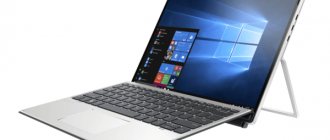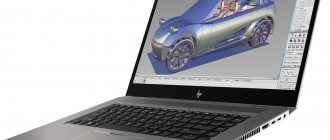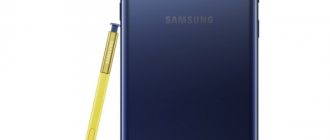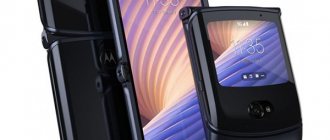To understand the performance level of any Android device, you can use one of the benchmark tests.
The test through Antutu has gained the most popularity, since its results help to see both the overall performance indicator and its individual components. All this data can be compared in real time with benchmarks.
Thanks to the use of combined testing techniques, it is possible to achieve the most accurate result, expressed in digital form. In order to decipher it, you do not need to be well versed in technology.
You just need to see which device has a higher number according to one or more indicators.
Why are Antutu ratings so popular?
In addition to ease of use, the Antutu benchmark test became popular due to the timing of its appearance. The first version was released during the existence of the second generation of the operating system. It continued to develop, acquiring more and more new functionality.
Over time, the developer split the test into two separate applications so that less data would be downloaded when updating.
The main application was able to test all parameters except 3D performance. In addition, there were simple checks for the device modules, including filling the display with a uniform color to check for dead pixels.
You could also find a small utility there that allows you to find out the number of touches supported by the touchscreen at the same time.
At the moment, a full performance test is carried out using the following parameters:
- Performance when working with databases.
- Processor performance for operations with integers.
- Processor performance for floating point operations.
- CPU performance in multi-core mode.
- RAM performance.
- Built-in storage performance.
- Data processing speed of an external memory card.
- Graphics chip performance.
The final result consists of the sum of the values obtained when checking each individual subsystem. Let's look at the results of the top new products available for sale in 2021.
No. 3 – ASUS Rog Phone 5
Result in AnTuTu: 807,388 points
The gaming smartphone from ASUS receives top bronze. With a similar filling, it scores more points due to software optimization. The device comes with a special gaming mode, plus you can connect a whole bunch of gaming accessories to it: joysticks, triggers, etc. The 144 Hz display with a diagonal of 6.78 inches allows you to enjoy the gameplay.
ASUS Rog Phone 5
IQOO 7
Performance according to Antutu: 727,935.
This smartphone is built on a powerful Qualcomm Snapdragon 888 processor. Thanks to the presence of both productive and energy-efficient cores, it saves battery power when using the smartphone for everyday tasks.
There are versions equipped with 8 and 12 GB of RAM, which is enough to simultaneously run several demanding games or programs. The built-in storage can have a capacity of 128 or 256 GB. No other versions are available.
The device runs the latest version of Android 11, equipped with the proprietary Origin OS shell. As befits modern top-end solutions, the gadget supports communications based on fifth-generation network technology.
The built-in battery has a capacity of 4000 mAh and can be charged using 120-watt fast charging.
pros:
- high performance;
- high-quality audio DAC;
- very fast charging.
Minuses:
- raw branded casing;
- too inconspicuous design.
Asus Zenfone 8 – 832666
Asus rarely releases budget or mid-range smartphones. Its target audience is people who are ready to spend extra money for a comfortable gaming experience. In the line of smartphones from this manufacturer, Zenfone 8 has a significant advantage, both in performance and in terms of hype.
When you first pick up the phone, it seems like this is an ordinary budget smartphone that will barely run any shooting game. This opinion may be formed due to the minimalistic design and small screen diagonal of 5.9 inches. The additional button on the body doesn’t even look good for this supposedly budget phone. In fact, hidden under the hood of the gadget is 8 GB of RAM and a Qualcomm Snapdragon 888 5G processor.
Advantages:
- weight – 169 grams (still the smallest in the top);
- memory – 128 GB;
- additional convenient button.
Flaws:
- screen resolution;
- price;
- RAM – 8 GB.
Price: 66,000 rubles.
Xiaomi Mi 11
Antutu performance: 710,889.
Top model from a well-known manufacturer, already available for sale. Equipped with a Snapdragon 888 processor operating at frequencies up to 2.84 GHz. The video system is an integrated Adreno 660 solution with a core frequency of up to 840 MHz.
Versions are available with 8 and 12 GB of RAM operating at 3.2 GHz. The user can choose the amount of internal memory among two versions: 128 and 256 GB. The display will please fans of large smartphones, because its size is as much as 6.81“, while the resolution is classic - 1080x2340 pixels.
A high-quality camera with a 108 megapixel matrix is installed. The 4600 mAh battery is enough for a day of active use, or for several hours of continuous play.
pros:
- presence of a stable proprietary shell;
- the latest Android;
- high quality camera.
Minuses:
- may be too big for some users;
- does not support the simultaneous installation of two SIM cards with a memory card.
Oppo Realme GT 5G – 817679
Unlike the model above, the developers of this phone took into account that customers do not come to the store with unlimited cards and thick wallets. The phone is distinguished by its low price and full correspondence between price and quality. Qualcomm Snapdragon 888 and 8 GB of RAM are installed on board. Memory as much as 128 GB. It may not be the most powerful option, but it covers all the needs of even the most avid users.
Advantages:
- stereo speakers;
- price;
- memory.
Flaws:
- no protection against water and dust.
Price: 40,000 rubles.
Huawei Mate 40 Pro+
Performance according to Antutu: 702,819.
The developers decided to use one of the highest frequency processors when creating this smartphone. As a result, he received the HiSilicon Kirin 9000, which has eight cores, one of which can be clocked at 3.13 GHz, which is the highest among mobile electronics.
There is only one memory version available. It has 12 GB of RAM, and the internal storage allows you to save up to 256 GB of data.
The device currently runs Android 10 with the proprietary EMUI 11 shell, but the manufacturer promises an update to the latest version in the near future. The ability to do 3D shooting using one of the built-in cameras deserves special attention.
pros:
- unusual appearance;
- catchy design;
- Availability of powerful fast charging.
Minuses:
- there is no latest version of Android;
- crude firmware that requires improvement.
Huawei Mate 40 Pro
Performance according to Antutu: 686,835.
Junior version of the top new product from the Chinese giant. It is equipped with exactly the same Kirin 9000 processor, but it has only 8 GB of LPDDR5 RAM.
The Chinese market has a version equipped with a 256 GB drive, while the rest of the world can choose between 128, 256 and 512 GB drives. The display resolution is identical and is 2772x1344 pixels. It is protected by sixth generation Gorilla Glass.
The main camera is a triple module assembled in a circular insert on the rear panel. The resolution of the largest matrix is 50 MP. The built-in battery has a capacity of 4400 mAh and can be charged using fast charging technology with a power of up to 50 W.
pros:
- top processor from its family;
- availability of good cameras for different purposes;
- attractive design.
Minuses:
- not the latest version of Android;
- unstable operation of the shell.
OPPO Reno5 Pro+
Performance according to Antutu: 689,036.
It is a flagship new product from the famous company Oppo. Equipped with a Snapdragon 865 processor operating at up to 2.84 GHz. It has built-in Adreno 650 graphics, which is enough to run any demanding games from the app store.
Released in several versions with 8 or 12 GB of LPDDR4 RAM and 128 or 256 GB of internal memory. The operating system is Android 11 with the proprietary ColorOS 11.1 shell. The manufacturer promises long-term support and the release of new firmware versions.
The main camera is a block of 4 matrices, the largest of which has a resolution of 50 MP. The smartphone supports fast charging up to 65 W, which is enough for a 4500 mAh battery.
pros:
- high-quality display with good color rendering;
- the ability to select versions with different amounts of memory;
- latest version of Android.
Minuses:
- no slot for memory cards;
- Not a very comfortable branded shell.
ZTE nubia Red Magic 6 Pro – 843816
ZTE has been among the top most popular Chinese manufacturers for several years in a row. Of course, it mainly specializes in budget models for a wide range of people, but there are exceptions. Nubia Red Magic 6 Pro is a gaming flagship that features a powerful eight-core Qualcomm SM8350 Snapdragon 888 processor with a high benchmark, on which any game runs at “ultra”.
Hidden under the hood are 256 GB of internal memory, which is quite problematic to fill. The device is available in several versions of 12, 16 and 18 GB (512 GB ROM). By comparison, office computers only come with 4GB.
And now a pleasant moment for your eyes. The screen is AMOLED with a diagonal of 6.8 and a frequency of 165 Hz. The pixel density is 387 ppi. That is, the user will never encounter sudden frame changes and cloudy pictures, which significantly impair vision and the feeling of gameplay. And to top it all off, the device supports Quick Charge 5.0 fast charging at 120W. This is enough to fully charge the 5050 mAh battery, which is installed in the smartphone, in 10-20 minutes.
Advantages:
- internal memory speed;
- large screen;
- Quick Charge support.
Flaws:
- a bit heavy;
- price.
Price for e-catalog: 68,000 rubles.
iQOO 5
Performance according to Antutu: 677,256.
This smartphone is also based on the Snapdragon 865 processor. It is paired with 8 or 12 GB of LPDDR5 RAM, accelerating to a frequency of 2.75 GHz. The user can save programs and files to the built-in memory, the volume of which, depending on the version, is 128 or 256 GB.
To display information, a display with a diagonal of 6.56 inches and a resolution of 2376x1080 pixels is used. The gadget runs on the Android 10 operating system, equipped with the proprietary IQOO UI 1.5 shell.
The device is the youngest in the line of top-end devices from the manufacturer. But at the same time, it is equipped with high-quality cameras and can shoot video with a resolution of 8K and a frequency of 30 frames per second.
pros:
- availability of fast charging;
- powerful processor;
- large amount of RAM.
Minuses:
- too unremarkable design;
- Lack of memory card support.
AnTuTu rating of smartphones running on Android
| PLACE | SMARTPHONE MODEL | ANTUTU |
| 1 | Xiaomi Black Shark 3 Pro | 620952 |
| 2 | Xiaomi Mi 10 Pro | 605783 |
| 3 | Xiaomi Black Shark 3 | 604823 |
| 4 | Xiaomi Mi 10 | 560792 |
| 5 | Samsung Galaxy S20+ (Plus) | 520638 |
| 6 | Samsung Galaxy S20 Ultra | 507597 |
| 7 | Asus ROG Phone 2 | 507284 |
| 8 | Samsung Galaxy S20 | 499140 |
| 9 | Vivo NEX 3 5G | 497858 |
| 10 | OnePlus 7T | 494705 |
| 11 | Realme X2 Pro | 482480 |
| 12 | Huawei P40 Pro | 482457 |
| 13 | Huawei Mate 30 Pro | 480936 |
| 14 | OnePlus 7T Pro | 478275 |
| 15 | Samsung Galaxy Z Flip | 478175 |
| 16 | OnePlus 7 Pro | 473991 |
| 16 | Honor View 30 Pro | 476480 |
| 17 | OnePlus 7 | 468519 |
| 18 | Samsung Galaxy S10 Lite | 461528 |
| 19 | Huawei Mate 30 | 460627 |
| 20 | Samsung Galaxy Note 10+ (Plus) 12/256GB | 454500 |
| 20 | Samsung Galaxy Note 10+ (Plus) 12/512GB | 454500 |
| 21 | Samsung Galaxy Note 10 | 449922 |
| 22 | Samsung Galaxy Fold | 449909 |
| 23 | Xiaomi Mi 9 6/128GB | 436775 |
| 23 | Xiaomi Mi 9 6/64GB | 436775 |
| 24 | Huawei P40 | 431752 |
| 25 | Samsung Galaxy S10+ (Plus) 128Gb | 414080 |
| 25 | Samsung Galaxy S10+ (Plus) Ceramic 512Gb | 414080 |
| 25 | Samsung Galaxy S10+ (Plus) Ceramic 1024Gb | 414080 |
| 26 | Samsung Galaxy S10 128Gb | 410517 |
| 26 | Samsung Galaxy S10 512Gb | 410517 |
| 27 | Samsung Galaxy S10E | 409277 |
| 28 | Xiaomi Mi 9T Pro 6/64GB | 398456 |
| 28 | Xiaomi Mi 9T Pro 6/128GB | 398456 |
| 29 | Honor 20 Pro | 391410 |
| 30 | Honor 20 | 388523 |
| 31 | Huawei Nova 5T | 387803 |
| 32 | Huawei Mate 20 Pro | 385302 |
| 33 | Meizu 16S 8/128GB | 377652 |
| 33 | Meizu 16S 6/128GB | 357075 |
| 34 | Huawei Mate 20 | 356918 |
| 35 | Xiaomi Pocophone F1 | 353334 |
| 36 | Xiaomi Mi 8 | 350228 |
| 37 | Sony Xperia 1 | 338031 |
| 38 | Samsung Galaxy Note 10 Lite | 334902 |
| 39 | Samsung Galaxy S9+ Plus 64GB | 321853 |
| 39 | Samsung Galaxy S9+ Plus 128GB | 321853 |
| 39 | Samsung Galaxy S9+ Plus 256GB | 321853 |
| 40 | Samsung Galaxy Note 9 512GB | 321598 |
| 40 | Samsung Galaxy Note 9 128GB | 321598 |
| 41 | Huawei P40 Lite | 317376 |
| 42 | Sony Xperia XZ3 | 291170 |
| 43 | Samsung Galaxy S9 64GB | 286856 |
| 43 | Samsung Galaxy S9 128GB | 286856 |
| 43 | Samsung Galaxy S9 256GB | 286856 |
| 44 | Asus Zenfone 6 ZS630KL | 286472 |
| 45 | Huawei P30 Pro | 286152 |
| 46 | Xiaomi Redmi Note 8 Pro 6/64GB | 283049 |
| 46 | Xiaomi Redmi Note 8 Pro 6/128GB | 283049 |
| 47 | Xiaomi Redmi Note 9S | 280529 |
| 48 | Asus Rog Phone 1 ZS600KL | 276996 |
| 49 | Samsung Galaxy A71 | 272418 |
| 50 | Xiaomi Mi Note 10 Pro | 267827 |
| 51 | Huawei P30 | 265230 |
| 52 | Xiaomi Mi Note 10 | 264898 |
| 53 | Xiaomi Mi 9T 6/128GB | 257072 |
| 53 | Xiaomi Mi 9T 6/64GB | 257072 |
| 54 | Sony Xperia XZ2 | 254916 |
| 55 | Samsung Galaxy A80 | 250884 |
| 56 | Samsung Galaxy S8 | 232311 |
| 57 | Samsung Galaxy S8 Plus | 231189 |
| 58 | Xiaomi Mi 9 SE 6/128GB | 223441 |
| 58 | Xiaomi Mi 9 SE 6/64GB | 223441 |
| 59 | Huawei Nova 4 | 215981 |
| 60 | Xiaomi Mi 9 Lite 6/128GB | 215686 |
| 60 | Xiaomi Mi 9 Lite 6/64GB | 215686 |
| 61 | Xiaomi Redmi Note 7 Pro | 215060 |
| 62 | Samsung Galaxy A70 | 211080 |
| 63 | Meizu X8 | 202714 |
| 64 | Samsung Galaxy A51 6/128GB | 186846 |
| 65 | Samsung Galaxy M30S | 180011 |
| 66 | Samsung Galaxy A51 4/64GB | 176748 |
| 67 | Honor 9X Premium | 176538 |
| 68 | Xiaomi Mi A3 | 176395 |
| 69 | Samsung Galaxy A50 6/128GB | 176232 |
| 70 | Meizu Note 9 4/64GB | 174905 |
| 70 | Meizu Note 9 4/128GB | 174905 |
| 71 | Honor 9X | 172127 |
| 72 | Nokia 7.2 | 171566 |
| 73 | Xiaomi Redmi Note 8 4/128GB | 170973 |
| 73 | Xiaomi Redmi Note 8 4/64GB | 170973 |
| 74 | Xiaomi Redmi Note 7 4/128GB | 170568 |
| 74 | Xiaomi Redmi Note 7 4/64GB | 170568 |
| 75 | Xiaomi Redmi Note 8T 4/128GB | 168928 |
| 75 | Xiaomi Redmi Note 8T 4/64GB | 168928 |
| 76 | Xiaomi Redmi Note 7 3/32GB | 168387 |
| 77 | Xiaomi Mi A2 | 166962 |
| 78 | Huawei P smart Z | 165386 |
| 79 | Huawei P30 Lite | 163851 |
| 80 | Xiaomi Redmi Note 8T 3/32GB | 162700 |
| 81 | Honor 20S | 162140 |
| 82 | Samsung Galaxy A50 4/64GB | 161575 |
| 83 | Xiaomi Redmi Note 8 3/32GB | 156700 |
| 84 | Honor 10 Lite | 149629 |
| 85 | Xiaomi Redmi Note 5 4/64GB | 147937 |
| 86 | Samsung Galaxy A7 (2018) | 145060 |
| 87 | Honor 10i | 141868 |
| 88 | Nokia 7 Plus | 141107 |
| 89 | Huawei Nova 3i | 139683 |
| 90 | Honor 20 Lite | 138697 |
| 91 | Asus Zenfone Max Pro (M2) ZB631KL | 127962 |
| 92 | Samsung Galaxy A40 | 127724 |
| 93 | Huawei P Smart 2019 | 120825 |
| 94 | Samsung Galaxy A20 | 119836 |
| 95 | Sony Xperia 10 Plus | 117658 |
| 96 | Asus ZenFone Max Pro M1 (ZB602KL) | 113119 |
| 97 | Asus Zenfone Max (M2) ZB633KL 4/64GB | 110279 |
| 98 | Samsung Galaxy A30S | 110277 |
| 99 | Meizu Note 8 | 110235 |
| 100 | Samsung Galaxy M20 64GB | 109452 |
| 101 | Samsung Galaxy A30 4/64GB | 107475 |
| 102 | Samsung Galaxy A10 | 107182 |
| 103 | Samsung Galaxy M20 32GB | 106445 |
| 104 | Samsung Galaxy A30 3/32GB | 106253 |
| 105 | Asus Zenfone Max (M2) ZB633KL 3/32GB | 100498 |
| 106 | Xiaomi Redmi 8 4/64GB | 97134 |
| 107 | Huawei Y6s | 94793 |
| 108 | Samsung Galaxy A01 | 92522 |
| 109 | Sony Xperia 10 | 90961 |
| 110 | Honor 8A | 86388 |
| 111 | Xiaomi Redmi 8A 4/64GB | 87280 |
| 112 | Nokia 4.2 | 86145 |
| 113 | Samsung Galaxy A20S | 85425 |
| 114 | Sony Xperia L3 | 76583 |
| 115 | Xiaomi Redmi 7A | 76350 |
| 116 | Xiaomi Redmi 8 3/32GB | 75188 |
| 117 | Xiaomi Redmi 8A 3/32GB | 74199 |
| 118 | ZTE Blade V10 Vita 3/64GB | 74097 |
| 119 | ZTE Blade A7 (2019) | 73277 |
| 120 | ZTE Blade V9 | 71735 |
| 121 | Samsung Galaxy A6 Plus | 70700 |
| 122 | Huawei Y6 (2019) | 67531 |
| 123 | Huawei Y5 (2019) | 65314 |
| 124 | Samsung Galaxy M10 3/32Gb | 64182 |
| 125 | Nokia 3.2 | 63474 |
| 126 | Samsung Galaxy A6 | 63105 |
| 127 | Meizu M6 Note 3/32Gb | 62517 |
| 128 | Honor 8S | 56445 |
| 129 | Samsung Galaxy J6 Plus | 56250 |
| 130 | ZTE Blade V10 Vita 2/32GB | 55400 |
| 131 | Nokia 2.2 | 53164 |
| 132 | Samsung Galaxy M10 2/16Gb | 51000 |
| 133 | Huawei Y5 Lite | 46634 |
| 134 | Honor 7A | 46245 |
| 135 | Asus Zenfone Lite (L1) G553KL | 41357 |
| 136 | Nokia 1 Plus | 36245 |
| 137 | Zte Blade A3 (2019) | 27598 |
Redmi K30S Supreme Edition
Performance according to Antutu: 660 133.
The device is a representative of the mid-segment and is built on a top-end processor from MediaTek called Dimensity 1000+. May have 6 or 8 GB of RAM on board, as well as from 128 to 512 GB of space for saving user files and other data.
Equipped with high-quality cameras capable of shooting in wide-angle format and taking pictures even in low light conditions. The main camera module has a resolution of 64 MP.
The built-in 4500 mAh battery can be charged using chargers up to 33 W. There is a proprietary shell from Xiaomi, modified in accordance with the design of the device.
pros:
- attractive appearance;
- ability to work in fifth generation networks;
- availability of fast charging.
Minuses:
- the design may not be to everyone's taste;
- budget processor.
iQOO 5 Pro
Performance according to Antutu: 677,256.
Another productive model, built on the Qualcomm Snapdragon 865 processor. The manufacturer is supplied with RAM modules of 8 or 12 GB, and also has a built-in storage of a fixed capacity of 256 GB.
The Adreno 650 video core is used to process graphic information. It is output to an AMOLED display with a resolution of 2376x1080 pixels and a size of 6.56 inches. The gadget runs Android 10 OS, modified using the branded IQOO UI 1.5 shell.
To take photos and videos, a triple camera module is used, the largest of which has a resolution of 50 MP.
pros:
- powerful processor;
- interesting, bright design;
- ability to record video in 8K.
Minuses:
- not the latest version of Android;
- an unusual shell for many.
Rating of Xiaomi phones based on AnTuTu test results
The ranking of Xiaomi phones based on the results of the AnTuTu benchmark includes smartphones from the Mi, Redmi, POCO and Black Shark brands. The most powerful phone is in first place with the maximum result in the synthetic test. The rating is updated as new models are released.
AnTuTu Benchmark is a popular test that is designed to check the performance of smartphone components. The processor, graphics accelerator, speed of the device's RAM and internal memory (built-in and SD card) are tested, and multitasking performance is assessed. The peak performance of the smartphone, the stability of individual components and the entire platform as a whole are assessed.
Top 5 most productive Xiaomi smartphones today:
- 1
Black Shark 4 Pro867578 points
- 2
POCO F3 Pro821847 points
- 3
Xiaomi Mi 11 Ultra817225 points
- 4
Xiaomi Mi Mix Fold815000 points
- 5
Xiaomi Mi 11 Pro804210 points
Testing is carried out using an application of the same name, which anyone can download from Google Play and the App Store. After the application has received the results for the individual components, they are summed up to produce a total score corresponding to the performance level of the smartphone. This number of points is shown in the comparison table.
Please note that one Xiaomi phone model may have several modifications of RAM and internal memory. The test result is for the model with the maximum available memory size. You can view all modifications of the model in the Xiaomi smartphone catalog, or by clicking on the link on the phone name.
Below is a comparison table between Xiaomi phones based on the results of the AnTuTu benchmark test. Most have already been added, the rest will appear in the table soon.
| # | Xiaomi smartphone | Test result | AnTuTu version |
| 1 | Black Shark 4 Pro / Kaiser 6.67″ (1080 x 2400), Qualcomm Snapdragon 888, 16 GB, 512 GB, 4500 mAh, 64 MP | 867578 | v9 |
| 2 | POCO F3 Pro • Redmi K40 Pro • Mi 11X Pro / Haydn 6.67″ (1080 x 2400), Qualcomm Snapdragon 888, 8 GB, 256 GB, 4520 mAh, 64 MP | 821847 | v9 |
| 3 | Xiaomi Mi 11 Ultra / Star 6.81″ (1400 x 3200), Qualcomm Snapdragon 888, 12 GB, 512 GB, 5000 mAh, 50 MP | 817225 | v9 |
| 4 | Xiaomi Mi Mix Fold / Cetus 6.52″ (840 x 2520), Qualcomm Snapdragon 888, 16 GB, 512 GB, 5020 mAh, 108 MP | 815000 | v9 |
| 5 | Xiaomi Mi 11 Pro / Mars 6.81″ (1400 x 3200), Qualcomm Snapdragon 888, 12 GB, 256 GB, 5000 mAh, 50 MP | 804210 | v9 |
| 6 | Xiaomi 11T Pro / Vili 6.67″ (1080 x 2400), Qualcomm Snapdragon 888, 12 GB, 256 GB, 5000 mAh, 108 MP | 759000 | v9 |
| 7 | Xiaomi Mi Mix 4 / Odin 6.67″ (1080 x 2400), Qualcomm Snapdragon 888+, 12 GB, 512 GB, 4500 mAh, 108 MP | 755000 | v9 |
| 8 | Xiaomi Mi 11i • Redmi K40 Pro+ / Haydn 6.67″ (1080 x 2400), Qualcomm Snapdragon 888, 12 GB, 256 GB, 4520 mAh, 108 MP | 744877 | v9 |
| 9 | POCO F3 • Redmi K40 • Mi 11X / Alioth 6.67″ (1080 x 2400), Qualcomm Snapdragon 870, 12 GB, 256 GB, 4520 mAh, 48 MP | 714008 | v9 |
| 10 | Xiaomi Mi 11 / Venus 6.81″ (1440 x 3200), Qualcomm Snapdragon 888, 12 GB, 256 GB, 4600 mAh, 108 MP | 707306 | v8 |
| 11 | Redmi Note 10 Pro 5G • POCO X3 GT / Chopin 6.60″ (1080 x 2400), MediaTek Dimensity 1100, 8 GB, 256 GB, 5000 mAh, 64 MP | 690051 | v9 |
| 12 | Redmi K40 Gaming / Ares 6.67″ (1080 x 2400), MediaTek Dimensity 1200, 12 GB, 256 GB, 5065 mAh, 64 MP | 688989 | v9 |
| 13 | POCO F3 GT / Aresin 6.60″ (1080 x 2400), MediaTek Dimensity 1200, 6 GB, 128 GB, 5065 mAh, 64 MP | 677147 | v9 |
| 14 | Xiaomi 11T / Amber 6.67″ (1080 x 2400), MediaTek Dimensity 1200, 8 GB, 256 GB, 5000 mAh, 108 MP | 677000 | v9 |
| 15 | Xiaomi Mi 10 Pro / Cmi 6.67″ (1080 x 2340), Qualcomm Snapdragon 865, 12 GB, 512 GB, 4500 mAh, 108 MP | 676892 | v9 |
| 16 | Xiaomi Mi 10S / Thyme 6.67″ (1080 x 2340), Qualcomm Snapdragon 870, 12 GB, 256 GB, 4780 mAh, 108 MP | 675000 | v8 |
| 17 | Black Shark 3S / KleinPro 6.67″ (1080 x 2400), Qualcomm Snapdragon 865, 12 GB, 256 GB, 4729 mAh, 64 MP | 666280 | v8 |
| 18 | POCO F2 Pro • Redmi K30 Pro / lmi 6.67″ (1080 x 2400), Qualcomm Snapdragon 865, 12 GB, 512 GB, 4700 mAh, 64 MP | 664502 | v9 |
| 19 | Xiaomi Mi 10 / Umi 6.67″ (1080 x 2340), Qualcomm Snapdragon 865, 12 GB, 256 GB, 4780 mAh, 108 MP | 634200 | v9 |
| 20 | Black Shark 4 / Penrose 6.67″ (1080 x 2400), Qualcomm Snapdragon 870, 12 GB, 256 GB, 4500 mAh, 48 MP | 611235 | v9 |
| 21 | Black Shark 3 Pro / Mobius 7.10″ (1440 x 3120), Qualcomm Snapdragon 865, 12 GB, 512 GB, 5000 mAh, 64 MP | 596454 | v8 |
| 22 | Xiaomi Mi 10 Ultra / Cas 6.67″ (1080 x 2340), Qualcomm Snapdragon 865, 16 GB, 512 GB, 4500 mAh, 48 MP | 589000 | v8 |
| 23 | Xiaomi Mi 10T / 10T Pro • Redmi K30S Ultra / Apollo 6.67″ (1080 x 2400), Qualcomm Snapdragon 865, 8 GB, 256 GB, 5000 mAh, 108 MP | 588481 | v8 |
| 24 | Black Shark 3 / Klein 6.67″ (1080 x 2400), Qualcomm Snapdragon 865, 12 GB, 256 GB, 4720 mAh, 64 MP | 587664 | v8 |
| 25 | Xiaomi Mi 11 Lite 5G / Renoir 6.55″ (1080 x 2400), Qualcomm Snapdragon 780G, 8 GB, 256 GB, 4250 mAh, 64 MP | 567671 | v9 |
| 26 | Redmi K30 Ultra / Cezanne 6.67″ (1080 x 2400), MediaTek Dimensity 1000+, 8 GB, 512 GB, 4500 mAh, 64 MP | 539786 | v8 |
| 27 | Xiaomi 11 Lite 5G NE / Lisa 6.55″ (1080 x 2400), Qualcomm Snapdragon 778G, 8 GB, 256 GB, 4250 mAh, 64 MP | 512000 | v9 |
| 28 | Xiaomi Mi 9T Pro • Redmi K20 Pro / Raphael 6.39″ (1080 x 2340), Qualcomm Snapdragon 855, 8 GB, 256 GB, 4000 mAh, 48 MP | 511944 | v9 |
| 29 | POCO X3 Pro / Vayu, Bhima 6.67″ (1080 x 2400), Qualcomm Snapdragon 860, 8 GB, 256 GB, 5160 mAh, 48 MP | 481446 | v8 |
| 30 | Black Shark 2 Pro / Daultay 6.39″ (1080 x 2340), Qualcomm Snapdragon 855+, 12 GB, 512 GB, 4000 mAh, 48 MP | 464953 | v8 |
| 31 | Xiaomi Mi 9 Pro / Crux 6.40″ (1080 x 2340), Qualcomm Snapdragon 855+, 12 GB, 512 GB, 4000 mAh, 48 MP | 464857 | v8 |
| 32 | Xiaomi Mi MIX 3 5G / Andromeda 6.39″ (1080 x 2340), Qualcomm Snapdragon 855, 6 GB, 128 GB, 3200 mAh, 12 MP | 448172 | v8 |
| 33 | Black Shark 2 / Skywalker 6.39″ (1080 x 2340), Qualcomm Snapdragon 855, 12 GB, 256 GB, 4000 mAh, 48 MP | 442971 | v8 |
| 34 | Xiaomi Mi 9 / Cepheus 6.40″ (1080 x 2340), Qualcomm Snapdragon 855, 12 GB, 256 GB, 3300 mAh, 48 MP | 440736 | v8 |
| 35 | Redmi 10X 5G / Atom 6.57″ (1080 x 2400), MediaTek Dimensity 820, 8 GB, 256 GB, 4520 mAh, 48 MP | 415672 | v8 |
| 36 | Redmi 10X Pro 5G / Bomb 6.57″ (1080 x 2400), MediaTek Dimensity 820, 8 GB, 256 GB, 4520 mAh, 48 MP | 415672 | v8 |
| 37 | Xiaomi Mi MIX 2S / Polaris 5.99″ (1080 x 2160), Qualcomm Snapdragon 845, 8 GB, 256 GB, 3400 mAh, 12 MP | 376781 | v9 |
| 38 | Xiaomi Mi 8 / Dipper 6.21″ (1080 x 2248), Qualcomm Snapdragon 845, 8 GB, 256 GB, 3400 mAh, 12 MP | 357329 | v8 |
| 39 | Xiaomi Mi 8 Pro / Equuleus 6.21″ (1080 x 2248), Qualcomm Snapdragon 845, 8 GB, 128 GB, 3000 mAh, 12 MP | 357329 | v8 |
| 40 | Black Shark / Skr 5.99″ (1080 x 2160), Qualcomm Snapdragon 845, 8 GB, 256 GB, 4000 mAh, 12 MP | 355979 | v8 |
| 41 | Xiaomi Mi 11 Lite 4G / Courbet 6.55″ (1080 x 2400), Qualcomm Snapdragon 732G, 6 GB, 128 GB, 4250 mAh, 64 MP | 355871 | v9 |
| 42 | Xiaomi Mi 10 Lite / Monet 6.57″ (1080 x 2400), Qualcomm Snapdragon 765G, 8 GB, 256 GB, 4160 mAh, 48 MP | 350997 | v8 |
| 43 | Redmi Note 9T • Redmi Note 9 5G / Cannon, Cannong 6.53″ (1080 x 2340), MediaTek Dimensity 800U, 4 GB, 128 GB, 5000 mAh, 48 MP | 343150 | v8 |
| 44 | Xiaomi Mi MIX 3 / Perseus 6.39″ (1080 x 2340), Qualcomm Snapdragon 845, 10 GB, 256 GB, 3200 mAh, 12 MP | 340759 | v8 |
| 45 | Redmi Note 10 Pro / Sweet 6.67″ (1080 x 2400), Qualcomm Snapdragon 732G, 8 GB, 128 GB, 5020 mAh, 108 MP | 336250 | v9 |
| 46 | POCO F1 / Beryllium 6.18″ (1080 x 2246), Qualcomm Snapdragon 845, 8 GB, 256 GB, 4000 mAh, 12 MP | 332586 | v8 |
| 47 | Black Shark Helo / Nile 6.01″ (1080 x 2160), Qualcomm Snapdragon 845, 10 GB, 256 GB, 4000 mAh, 12 MP | 332385 | v8 |
| 48 | Xiaomi Mi 10 Lite Zoom • Mi 10 Youth Edition / Vangogh 6.57″ (1080 x 2400), Qualcomm Snapdragon 765G, 8 GB, 256 GB, 4160 mAh, 48 MP | 330587 | v8 |
| 49 | Xiaomi Mi 10T Lite 5G • Redmi Note 9 Pro 5G • Mi 10i / Gauguin, Gauguinpro 6.67″ (1080 x 2400), Qualcomm Snapdragon 750G, 6 GB, 128 GB, 4820 mAh, 64 MP | 330000 | v8 |
| 50 | Redmi K30i 5G / Picasso 48M 6.67″ (1080 x 2400), Qualcomm Snapdragon 765G, 8 GB, 256 GB, 4500 mAh, 48 MP | 325370 | v8 |
| 51 | Redmi K30 5G / Picasso 6.67″ (1080 x 2400), Qualcomm Snapdragon 765G, 8 GB, 256 GB, 4500 mAh, 64 MP | 325370 | v8 |
| 52 | POCO M3 Pro 5G / Camellian 6.50″ (1080 x 2400), MediaTek Dimensity 700, 6 GB, 128 GB, 5000 mAh, 48 MP | 324283 | v9 |
| 53 | Redmi Note 10S / Rosemary 6.43″ (1080 x 2400), MediaTek Helio G95, 8 GB, 128 GB, 5000 mAh, 64 MP | 321892 | v9 |
| 54 | Redmi Note 10 JE / Iris 6.50″ (1080 x 2400), Qualcomm Snapdragon 480, 4 GB, 64 GB, 4800 mAh, 48 MP | 321892 | v9 |
| 55 | POCO X3 NFC / Surya 6.67″ (1080 x 2400), Qualcomm Snapdragon 732G, 8 GB, 128 GB, 5160 mAh, 64 MP | 301581 | v8 |
| 56 | POCO X3 / Karna 6.67″ (1080 x 2400), Qualcomm Snapdragon 732G, 6 GB, 128 GB, 5160 mAh, 64 MP | 301581 | v8 |
| 57 | Redmi Note 10T • Redmi Note 10 5G • Redmi Note 10T 5G / Camellia, Camellian 6.50″ (1080 x 2400), MediaTek Dimensity 700, 6 GB, 128 GB, 5000 mAh, 48 MP | 299111 | v9 |
| 58 | Redmi Note 8 Pro / Begonia, Begoniain 6.53″ (1080 x 2340), MediaTek Helio G90T, 8 GB, 256 GB, 4500 mAh, 64 MP | 292510 | v8 |
| 59 | Redmi Note 8 2021 / Biloba 6.30″ (1080 x 2340), MediaTek Helio G85, 6 GB, 128 GB, 4000 mAh, 48 MP | 292000 | v9 |
| 60 | POCO X2 • Redmi K30 4G / Phoenix 6.67″ (1080 x 2400), Qualcomm Snapdragon 730G, 8 GB, 256 GB, 4500 mAh, 64 MP | 279521 | v8 |
| 61 | Redmi Note 10 / Mojito 6.43″ (1080 x 2400), Qualcomm Snapdragon 678, 6 GB, 128 GB, 5000 mAh, 48 MP | 277254 | v8 |
| 62 | Redmi Note 9 Pro / Joyeuse 6.67″ (1080 x 2400), Qualcomm Snapdragon 720G, 6 GB, 128 GB, 5020 mAh, 64 MP | 274596 | v8 |
| 63 | Redmi Note 9S • Redmi Note 9 Pro / Curtana 6.67″ (1080 x 2400), Qualcomm Snapdragon 720G, 6 GB, 128 GB, 5020 mAh, 48 MP | 274596 | v8 |
| 64 | Redmi Note 9 Pro Max / Excalibur 6.67″ (1080 x 2400), Qualcomm Snapdragon 720G, 8 GB, 128 GB, 5020 mAh, 64 MP | 274596 | v8 |
| 65 | Xiaomi Mi 9T • Redmi K20 / Davinci 6.39″ (1080 x 2340), Qualcomm Snapdragon 730, 8 GB, 256 GB, 4000 mAh, 48 MP | 265231 | v8 |
| 66 | Xiaomi Mi Note 10 Lite / Toco 6.47″ (1080 x 2340), Qualcomm Snapdragon 730G, 8 GB, 128 GB, 5260 mAh, 64 MP | 264493 | v8 |
| 67 | Xiaomi Mi Note 10 • Mi CC9 Pro / Tucana 6.47″ (1080 x 2340), Qualcomm Snapdragon 730G, 8 GB, 256 GB, 5260 mAh, 108 MP | 264493 | v8 |
| 68 | Xiaomi Mi Note 10 Pro / Tucana 6.47″ (1080 x 2340), Qualcomm Snapdragon 730G, 8 GB, 256 GB, 5260 mAh, 108 MP | 261306 | v8 |
| 69 | Xiaomi Mi 6 / Sagit 5.15″ (1080 x 1920), Qualcomm Snapdragon 835, 6 GB, 128 GB, 3350 mAh, 12 MP | 255178 | v8 |
| 70 | POCO M2 Pro / Gram 6.67″ (1080 x 2400), Qualcomm Snapdragon 720G, 6 GB, 128 GB, 5000 mAh, 48 MP | 237811 | v8 |
| 71 | POCO M2 / Shiva 6.67″ (1080 x 2400), MediaTek Helio G80, 6 GB, 128 GB, 5000 mAh, 13 MP | 237811 | v8 |
| 72 | Xiaomi Mi 9 SE / Grus 5.97″ (1080 x 2340), Qualcomm Snapdragon 712, 6 GB, 128 GB, 3070 mAh, 48 MP | 226183 | v8 |
| 73 | Xiaomi Mi 8 SE / Sirius 5.88″ (1080 x 2244), Qualcomm Snapdragon 710, 6 GB, 128 GB, 3120 mAh, 12 MP | 218159 | v8 |
| 74 | Xiaomi Mi 9 Lite • Mi CC9 / Pyxis 6.39″ (1080 x 2340), Qualcomm Snapdragon 710, 6 GB, 128 GB, 4030 mAh, 48 MP | 217225 | v8 |
| 75 | Redmi Note 7 Pro / Violet 6.3″ (1080 x 2340), Qualcomm Snapdragon 675, 6 GB, 128 GB, 4000 mAh, 48 MP | 210138 | v8 |
| 76 | Redmi 10 • Redmi 10 Prime / Atom 6.50″ (1080 x 2400), MediaTek Helio G88, 4 GB, 64 GB, 6000 mAh, 50 MP | 210000 | v8 |
| 77 | Xiaomi Mi MIX 2 / Chiron 5.99″ (1080 x 2160), Qualcomm Snapdragon 835, 8 GB, 256 GB, 3400 mAh, 12 MP | 206574 | v7 |
| 78 | Redmi Note 9 • Redmi 10X 4G / Merlin 6.53″ (1080 x 2340), MediaTek Helio G85, 6 GB, 128 GB, 5020 mAh, 48 MP | 205946 | v8 |
| 79 | Redmi 9 • Redmi 9 Prime / Lancelot, Galahad 6.53″ (1080 x 2340), MediaTek Helio G80, 4 GB, 128 GB, 5020 mAh, 13 MP | 203078 | v8 |
| 80 | Xiaomi Mi CC9 Meitu / Vela 6.39″ (1080 x 2340), Qualcomm Snapdragon 710, 8 GB, 256 GB, 4030 mAh, 48 MP | 189482 | v8 |
| 81 | POCO M3 / Citrus 6.53″ (1080 x 2340), Qualcomm Snapdragon 662, 6 GB, 128 GB, 6000 mAh, 48 MP | 185028 | v8 |
| 82 | Xiaomi Mi A3 • Mi CC9e / Laurel_sprout, laurus 6.09″ (720 x 1560), Qualcomm Snapdragon 665, 6 GB, 128 GB, 4030 mAh, 48 MP | 176750 | v8 |
| 83 | Xiaomi Mi 8 Lite • Mi 8 Youth Edition / Platina 6.26″ (1080 x 2280), Qualcomm Snapdragon 660, 6 GB, 128 GB, 3350 mAh, 12 MP | 174767 | v8 |
| 84 | Redmi 9T • Redmi Note 9 4G • Redmi 9 Power / Lime, Lemon, Pomelo 6.53″ (1080 x 2340), Qualcomm Snapdragon 662, 6 GB, 128 GB, 6000 mAh, 48 MP | 174500 | v8 |
| 85 | Redmi Note 8 / Ginkgo 6.30″ (1080 x 2340), Qualcomm Snapdragon 665, 6 GB, 128 GB, 4000 mAh, 48 MP | 170516 | v8 |
| 86 | Redmi Note 8T / Willow 6.30″ (1080 x 2340), Qualcomm Snapdragon 665, 4 GB, 128 GB, 4000 mAh, 48 MP | 170516 | v8 |
| 87 | Redmi Note 7 • Redmi Note 7S / Lavender 6.30″ (1080 x 2340), Qualcomm Snapdragon 660, 6 GB, 128 GB, 4000 mAh, 48 MP | 166147 | v8 |
| 88 | Xiaomi Mi 5s Plus / Natrium 5.7″ (1080 x 1920), Qualcomm Snapdragon 821, 6 GB, 128 GB, 3800 mAh, 13 MP | 165110 | v7 |
| 89 | Xiaomi Mi Note 2 / Scorpio 5.7″ (1080 x 1920), Qualcomm Snapdragon 821, 6 GB, 128 GB, 4070 mAh, 22.5 MP | 164907 | v7 |
| 90 | Xiaomi Mi Mix / Lithium 6.40″ (1080 x 2400), Qualcomm Snapdragon 821, 6 GB, 256 GB, 4400 mAh, 16 MP | 157865 | v7 |
| 91 | Xiaomi Mi 5s / Capricorn 5.15″ (1080 x 1920), Qualcomm Snapdragon 821, 4 GB, 128 GB, 3200 mAh, 12 MP | 146988 | v7 |
| 92 | Xiaomi Mi Note 3 / Jason 5.50″ (1080 x 1920), Qualcomm Snapdragon 660, 6 GB, 128 GB, 3500 mAh, 12 MP | 139313 | v7 |
| 93 | Xiaomi Mi A2 • Mi 6X / Jasmine, Wayne 5.99″ (1080 x 2160), Qualcomm Snapdragon 660, 6 GB, 128 GB, 3010 mAh, 12 MP | 134292 | v7 |
| 94 | Xiaomi Mi 5 / Gemini 5.15″ (1080 x 1920), Qualcomm Snapdragon 820, 4 GB, 128 GB, 3000 mAh, 16 MP | 131646 | v7 |
| 95 | Redmi 7 / Onclite 6.26″ (720 x 1520), Qualcomm Snapdragon 632, 4 GB, 64 GB, 4000 mAh, 12 MP | 124599 | v8 |
| 96 | Xiaomi Mi Max 3 / Nitrogen 6.90″ (1080 x 2160), Qualcomm Snapdragon 636, 6 GB, 128 GB, 5500 mAh, 12 MP | 118397 | v7 |
| 97 | Redmi Note 5 / Whyred, Vince 5.99″ (1080 x 2160), Qualcomm Snapdragon 636, 6 GB, 128 GB, 4000 mAh, 12 MP | 116663 | v7 |
| 98 | Redmi Note 6 Pro / Tulip 6.26″ (1080 x 2246), Qualcomm Snapdragon 636, 6 GB, 64 GB, 4000 mAh, 12 MP | 115991 | v7 |
| 99 | Redmi 9 (India) / Cattail 6.53″ (720 x 1600), MediaTek Helio G35, 4 GB, 128 GB, 5000 mAh, 13 MP | 111000 | v8 |
| 100 | Redmi 9C NFC / Ancelican 6.53″ (720 x 1600), Mediatek Helio G35, 3 GB, 64 GB, 5000 mAh, 13 MP | 110490 | v7 |
| 101 | POCO C3 / Angelicain 6.53″ (720 x 1600), Mediatek Helio G35, 4 GB, 64 GB, 5000 mAh, 13 MP | 110490 | v8 |
| 102 | Redmi 9C / Angelica 6.53″ (720 x 1600), Mediatek Helio G35, 4 GB, 64 GB, 5000 mAh, 13 MP | 110490 | v8 |
| 103 | Redmi Y3 / Onc 6.26″ (720 x 1520), Qualcomm Snapdragon 632, 4 GB, 64 GB, 4000 mAh, 12 MP | 103584 | v7 |
| 104 | Redmi 9A • Redmi 9i / Dandelion 6.53″ (720 x 1600), Mediatek Helio G25, 6 GB, 128 GB, 5000 mAh, 13 MP | 102778 | v8 |
| 105 | Xiaomi Mi Max / Hydrogen 6.44″ (1080 x 1920), Qualcomm Snapdragon 650, 4 GB, 128 GB, 4850 mAh, 16 MP | 97223 | v7 |
| 106 | Redmi 8 / Olive 6.22″ (720 x 1520), Snapdragon 439, 4 GB, 64 GB, 5000 mAh, 12 MP | 95565 | v8 |
| 107 | Redmi 8A Pro • Redmi 8A Dual / Olivewood 6.22″ (720 x 1520), Qualcomm Snapdragon 439, 2 GB, 32 GB, 5000 mAh, 13 MP | 95565 | v8 |
| 108 | Redmi 8A / Olivelite 6.22″ (720 x 1520), Qualcomm Snapdragon 439, 4 GB, 64 GB, 5000 mAh, 12 MP | 95565 | v8 |
| 109 | Xiaomi Mi 5c / Meri 5.15″ (1080 x 1920), Xiaomi Surge S1, 3 GB, 64 GB, 2860 mAh, 12 MP | 91690 | v7 |
| 110 | Redmi Note 3 Pro / Kenzo 5.50″ (1080 x 1920), Qualcomm Snapdragon 650, 3 GB, 32 GB, 4050 mAh, 16 MP | 91531 | v7 |
| 111 | Redmi Note 4X / Mido, Nikel 5.50″ (1080 x 1920), Qualcomm Snapdragon 625, 4 GB, 64 GB, 4100 mAh, 13 MP | 90726 | v7 |
| 112 | Redmi 7A / Pine 5.45″ (720 x 1440), Qualcomm Snapdragon 439, 4 GB, 64 GB, 4000 mAh, 12 MP | 90664 | v8 |
| 113 | Xiaomi Mi Play / Lotus 5.84″ (1080 x 2280), MediaTek Helio P35, 6 GB, 128 GB, 3000 mAh, 12 MP | 86352 | v7 |
| 114 | Xiaomi Mi A1 • Mi 5X / Tissot, Tiffany 5.50″ (1080 x 1920), Qualcomm Snapdragon 625, 4 GB, 64 GB, 3080 mAh, 12 MP | 78150 | v7 |
| 115 | Redmi S2 • Redmi Y2 / Ysl 5.99″ (720 x 1440), Qualcomm Snapdragon 625, 4 GB, 64 GB, 3080 mAh, 12 MP | 78004 | v7 |
| 116 | Xiaomi Mi Max 2 / Oxygen 6.44″ (1080 x 1920), Qualcomm Snapdragon 625, 4 GB, 128 GB, 5300 mAh, 12 MP | 77231 | v7 |
| 117 | Redmi 5 Plus • Redmi Note 5 / Vince 5.99″ (1080 x 2160), Qualcomm Snapdragon 625, 4 GB, 54 GB, 4000 mAh, 12 MP | 76883 | v7 |
| 118 | Xiaomi Mi A2 Lite • Redmi 6 Pro / Daisy, Sakura 5.84″ (1080 x 2280), Qualcomm Snapdragon 625, 4 GB, 64 GB, 4000 mAh, 12 MP | 76500 | v8 |
| 119 | Redmi Note 4 / Mido, Nikel 5.50″ (1080 x 1920), Qualcomm Snapdragon 625, 4 GB, 64 GB, 4100 mAh, 13 MP | 75984 | v7 |
| 120 | Redmi 6 / Cereus 5.45″ (720 x 1440), MediaTek Helio P22, 4 GB, 64 GB, 3000 mAh, 12 MP | 75399 | v7 |
| 121 | Redmi 5 / Rosy 5.70″ (720 x 1440), Qualcomm Snapdragon 450, 4 GB, 32 GB, 3300 mAh, 12 MP | 70000 | v7 |
| 122 | Xiaomi Mi 4c / Libra 5″ (1080 x 1920), Qualcomm Snapdragon 808, 3 GB, 32 GB, 3080 mAh, 13 MP | 67981 | v7 |
| 123 | Xiaomi Mi Note / Virgo 5.70″ (1080 x 1920), Qualcomm Snapdragon 801, 3 GB, 64 GB, 3000 mAh, 13 MP | 64537 | v7 |
| 124 | Redmi 4 Prime / Markw 5.0″ (1080 x 1920), Qualcomm Snapdragon 625, 3 GB, 32 GB, 4100 mAh, 13 MP | 62359 | v7 |
| 125 | Xiaomi Mi 4s / Aqua 5″ (1080 x 1920), Qualcomm Snapdragon 808, 3 GB, 64 GB, 3260 mAh, 13 MP | 61841 | v7 |
| 126 | Xiaomi Mi 4 / Cancro 5″ (1080 x 1920), Qualcomm Snapdragon 801, 3 GB, 64 GB, 3080 mAh, 13 MP | 61493 | v7 |
| 127 | Redmi 6A / Cactus 5.45″ (720 x 1440), MediaTek Helio A22, 3 GB, 32 GB, 3000 mAh, 13 MP | 55277 | v7 |
| 128 | Xiaomi Mi 3 / Pisces, Cancro 5″ (1080 x 1920), Qualcomm Snapdragon 800, 2 GB, 64 GB, 3050 mAh, 13 MP | 54271 | v7 |
| 129 | Redmi Note 3 / Hennessey, Kenzo, Kate 5.50″ (1080 x 1920), MediaTek Helio X10 2.0, 3 GB, 32 GB, 4000 mAh, 13 MP | 49889 | v7 |
| 130 | Redmi Note 2 / 2 Prime / Hermes 5.50″ (1080 x 1920), MediaTek Helio X10 2.0, 2 GB, 32 GB, 3060 mAh, 13 MP | 48022 | v7 |
| 131 | Redmi 4A / Rolex 5″ (720 x 1280), Qualcomm Snapdragon 425, 3 GB, 32 GB, 3120 mAh, 13 MP | 43869 | v7 |
| 132 | Redmi 4x / Santoni 5.0″ (720 x 1280), Qualcomm Snapdragon 430, 2 GB, 16 GB, 4100 mAh, 13 MP | 42989 | v7 |
| 133 | Redmi 4 / Prada 5.0″ (720 x 1280), Qualcomm Snapdragon 430, 2 GB, 16 GB, 4100 mAh, 13 MP | 42989 | v7 |
| 134 | Xiaomi Mi 4i / Ferrari 5″ (1080 x 1920), Qualcomm Snapdragon 615, 2 GB, 32 GB, 3120 mAh, 13 MP | 40253 | v7 |
| 135 | Redmi 3s • Redmi 3x / Land 5″ (720 x 1280), Qualcomm Snapdragon 430, 3 GB, 32 GB, 4100 mAh, 13 MP | 37647 | v7 |
| 136 | Redmi 3 / Ido_xhdpi 5.0″ (720 x 1280), Qualcomm Snapdragon 616, 2 GB, 64 GB, 4100 mAh, 13 MP | 33726 | v7 |
| 137 | Redmi 5A / Riva 5″ (720 x 1280), Qualcomm Snapdragon 425, 3 GB, 32 GB, 3000 mAh, 13 MP | 32000 | v7 |
| 138 | Redmi Note 5A • Redmi Note 5A Prime • Redmi Y1 Lite / Ugglite 5.50″ (720 x 1280), Qualcomm Snapdragon 425, 4 GB, 64 GB, 3080 mAh, 13 MP | 32000 | v7 |
| 139 | Redmi Go / Tiare 5″ (720 x 1280), Qualcomm Snapdragon 425, 1 GB, 16 GB, 3000 mAh, 8 MP | 32000 | v7 |
| 140 | Xiaomi Mi 2 / Mi 2s / Aries 4.30″ (720 x 1280), Qualcomm Snapdragon 600, 2 GB, 32 GB, 2000 mAh, 8 MP | 24763 | v7 |
| 141 | Redmi 2 / 2A • Hongmi 2 / wt88047 4.70″ (720 x 1280), Qualcomm Snapdragon 410, 2 GB, 16 GB, 2200 mAh, 8 MP | 23559 | v7 |
| 142 | Xiaomi Mi 2A / Taurus 4.50″ (720 x 1280), Qualcomm Snapdragon S4 Plus, 1 GB, 16 GB, 2030 mAh, 8 MP | 21470 | v7 |
| 143 | Xiaomi Mi 1S / 1S Lite / Mione_plus 4.0″ (480x854), Qualcomm Snapdragon S3, 1 GB, 4 GB, 1930 mAh, 8 MP | 21467 | v7 |
| 144 | Redmi 1S • Hongmi 1S / Armani 4.70″ (720 x 1280), Qualcomm Snapdragon 400, 1 GB, 8 GB, 2000 mAh, 8 MP | 21467 | v7 |
| 145 | Redmi 1 / wt93007 / wt98007 4.70″ (720 x 1280), Mediatek MT6589T, 1 GB, 4 GB, 2000 mAh, 8 MP | 19677 | v7 |
| 146 | Xiaomi Mi 1 / Mi 1 Lite / Mione_plus 4.0″ (480 x 854), Qualcomm Snapdragon S3, 1 GB, 8 GB, 1930 mAh, 8 MP | no data |
In the table you can see several versions of AnTuTu: v7, v8, v9. They only indicate the version of the official application with which testing was carried out. AnTuTu testing algorithms do not change from version to version, it’s just that older versions of the program do not support new Xiaomi models.
Test results depend on the version of the operating system, cache load, amount of free RAM and other factors. Therefore, the number of benchmark points for one phone on different sites may vary slightly. It is even important how the testing was carried out: for example, during the test you cannot tap on the screen, otherwise the numbers will be incorrect.
The ranking of the most productive Xiaomi smartphones is generated automatically, based on the performance of the official AnTuTu test. However, our rating has several differences from a similar rating on the official AnTuTu website:
- The AnTuTu website provides ratings for all smartphone manufacturers, including Samsung, OPPO, Asus, Huawei, Apple and other companies. Our rating focuses only on Xiaomi brand phones - Mi, Redmi, POCO and Black Shark.
- The AnTuTu Benchmark rating displays only popular models and is updated no more than once a month, or even less often. Our rating is updated upon the release of a new Xiaomi smartphone and shows all the company's existing phones.
- Antutu.com presents only global versions; there are no models for the Chinese domestic market. Xiaomi smartphones for all markets, including China, are also present here.
It is important to understand that the test results in the AnTuTu application cannot answer the question of which Xiaomi phone is better. You can find out which is the most productive, nothing more. The reason is simple: phone models differ in color, size, screen quality, and have different battery life. There is no need to even talk about the number and capabilities of cameras.
To choose the best Xiaomi phone, pay attention to the first 30-35 places in the ranking - these are productive smartphones that will not lose relevance over the coming years. Among them you will definitely be able to choose an interesting device at an affordable price.
If you think that a specific phone model is not listed in the top, write to us. Any questions, wishes and suggestions regarding the rating can be sent through any contact.
Vivo X50 Pro+
Antutu performance: 661,343.
This model runs on a seventh generation processor from Qualcomm called Snapdragon 765G. Its frequency can reach 2.4 GHz at peak loads.
It includes an Adreno 620 video core, which is enough to comfortably play and run almost all heavy applications from the store that currently exist. A version equipped with 8 GB of RAM and 128 or 256 GB of internal memory is available to users.
The battery has a capacity of 4315 mAh and is made using lithium polymer technology. The operating system is Android 10 with FunTouch OS 10.5 shell.
pros:
- attractive appearance;
- good camera;
- large amount of built-in memory.
Minuses:
- not the latest version of Android;
- previous generation processor.











